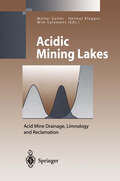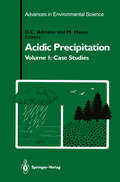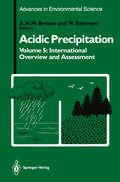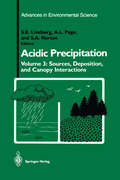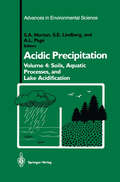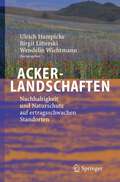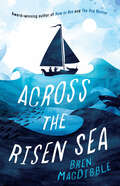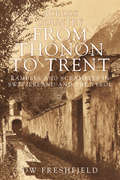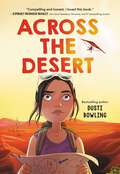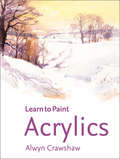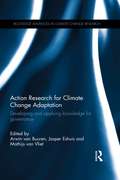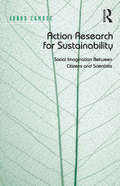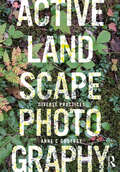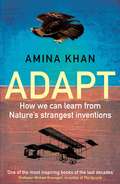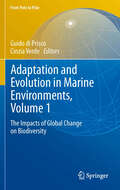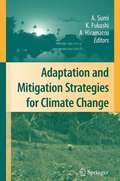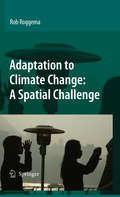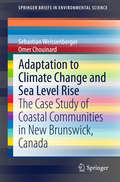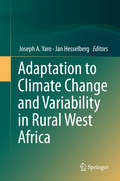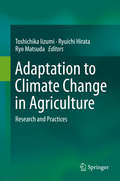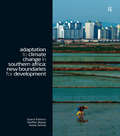- Table View
- List View
Acidic Mining Lakes: Acid Mine Drainage, Limnology and Reclamation (Environmental Science and Engineering)
by Wim Salomons, Helmut Klapper, Walter GellerAcidification is a universal problem at all mining sites in which oxygenated water comes in contact with sulfide minerals or other reduced sulfur compounds. An International Workshop was held in September 1995 at the Department for Inland Water Research of the UFZ-Centre for Environmental Research in Magdeburg on the limnology of lakes created by open-cast lignite mining, emphasizing the often observed geogenic acidification after oxidation of pyrite. The volume has 25 chapters including a chapter with results of group discussions about the topics mentioned above and further problems that were identified during the meeting. The monograph gives a baseline of the state of science on the worldwide problem of geogenic acidification of lakes following human mining activities.
Acidic Precipitation: Case Studies (Advances in Environmental Science #1)
by D. C. Adriano M. Havas"awareness" of the world's citizens and encourage governments to devote more attention and resources to address this issue. The series editors thank the international panel of contributors for bringing this timely series into completion. We also wish to acknowledge the very insightful input of the following colleagues: Prof. A.L. Page of the University of California, Prof. T.C. Hutchinson of the University of Toronto, and Dr. Steve Lindberg of the Oak Ridge National Laboratory. We also wish to thank the superb effort and cooperation of the volume editors in handling their respective volumes. The constructive criticisms of chapter review ers also deserve much appreciation. Finally, we wish to convey our appreciation to my secretary, Ms. Brenda Rosier, and my technician, Ms. Claire Carlson, for their very able assistance in various aspects of this series. Aiken, South Carolina Domy C. Adriano Coordinating Editor Preface to Acidic Precipitation, Volume 1 (Advances in Environmental Science) As a result of pioneering research in the 1960s and because of the perceived and acidic real environmental effects described during the ensuing years, the terms rain, acidic deposition, or acidic precipitation have become commonplace in the scientific and popular literature. In the last decade, governments throughout the world have responded to public pressure and to the concerns of the scientific community by establishing research programs on national and international scales.
Acidic Precipitation: International Overview and Assessment (Advances in Environmental Science #5)
by A. H. M. Bresser W. Salomons Wim Salomons"awareness" of the world's citizens and encourage governments to devote more attention and resources to address this issue. The series editors thank the international panel of contributors for bringing this timely series into completion. We also wish to acknowledge the very insightful input of the following colleagues: Prof. A. L. Page of the University of California, Prof. T . C. Hutchinson of the University of Toronto , and Dr. Steve Lindberg of the Oak Ridge National Laboratory. We also wish to thank the superb effort and cooperation of the volume editors in handling their respective volumes. The constructive criticisms of chapter review ers also deserve much appreciation. Finally, we wish to convey our appreciation to my secretary, Ms. Brenda Rosier, and my technician, Ms. Claire Carlson, for their very able assistance in various aspects of this series. Aiken, South Carolina Domy C. Adriano Coordinating Editor Preface to Acidic Precipitation, Volume 5 (Advances in Environmental Science) Acidification research has been ongoing for several decades. It was not until the 1980s, however, that scientists began to recognize the complex ity of the factors causing the decline in forest growth and deterioration of fish populations in acidified lakes. The general feeling, based on correla tive research, was that long-range transported air pollution was the main cause. Proof, however, was difficult to obtain because of complex interac tions of various stress factors including natural ones.
Acidic Precipitation: Sources, Deposition, and Canopy Interactions (Advances in Environmental Science #3)
by S. E. Lindberg Al Page S. A. Nortoncountries accelerating to reach a consensus on the role that atmospheric emissions and acidic precipitation play in the environment, publication of this series is timely. The editors thank the contributors to this volume for their efforts in describing a wide array of atmospheric topics, all of which are important to an understanding of the acidic precipitation issue. Oak Ridge, Tennessee Steven E Lindberg Riverside, California Albert L. Page Orono, Maine Stephen A. Norton Contents Series Preface .................................................... v Preface... ....... ...... ..... ... .. ............................... .. vii Contributors ..................................................... xiii Sources of Acids, Bases, and Their Precursors in the Atmosphere . . . 1 Roger L. Tanner I. Introduction and Definitions. . . . . . . . . . . . . . . . . . . . . . . . . . . . . . . . . . . . . . 1 II. Sources of Acids ............................................... 3 III. Sources of Acid-Neutralizing Substances (Bases) ................... 9 IV. Distribution of Atmospheric Acids and Bases ...................... 10 V. Gas-Aerosol Equilibria and Boundary Layer Mixing ................ 14 VI. Summary of Significant Acid-Formation Pathways.............. . .. . 15 References ................................•................... 17 Aerosol Sulfur Association with Aluminum in Eastern North America: Evidence for Solubilization of Atmospheric Trace Metals before Deposition ......... . . . . . . . . . . 21 . . .
Acidic Precipitation: Soils, Aquatic Processes, and Lake Acidification (Advances in Environmental Science #4)
by Stephen A. Norton S. E. Lindberg Al Pagevarious places of the world. Thus, it is hoped that this up-to-date subseries would increase the "awareness" of the world's citizens and encourage governments to devote more attention and resources to address this issue. The series editors thank the international panel of contributors for bringing this timely series into completion. We also wish to acknowledge the very insightful input of the following colleagues: Prof. A. L. Page ofthe University of California, Prof. T. C. Hutchinson of the University of Toronto, and Dr. Steve Lindberg of the Oak Ridge National Laboratory. We also wish to thank the superb effort and cooperation of the volume editors in handling their respective volumes. The constructive criticisms of chapter reviewers also deserve much appreciation. Finally, we wish to convey our appreciation to my secretary, Ms. Brenda Rosier, and my technician, Ms. Claire Carlson, for their very able assistance in various aspects of this series. Aiken, South Carolina Domy C. Adriano Coordinating Editor Preface to Acidic Precipitation, Volume 4 (Advances in Environmental Science) Acidic precipitation and its effects have been the focus ofintense research for over two decades. Initially, research centered on the acidity status and acidification of surface waters and consequent impact on the status of sports fisheries; evidence suggested impacts on fisheries in Sweden and Norway, and in North America, in eastern Ontario, Quebec, and in the Adirondack Mountains of New York.
Ackerlandschaften: Nachhaltigkeit und Naturschutz auf ertragsschwachen Standorten
by Ulrich Hampicke Birgit Literski Wendelin WichtmannIn weiten Gebieten Mitteleuropas ist Ackerbau auf ertragsschwachen Standorten nur mit öffentlicher Förderung kostendeckend. Diese ist für die nähere Zukunft gesichert, langfristig aber ungewiss. Eine großflächige Aufgabe des Ackerbaus wäre aus zahlreichen Gründen problematisch. Ausgehend von einer historischen Betrachtung untersucht dieses Buch Perspektiven eines extensiven, multifunktionellen Ackerbaus, der Naturschutz und Erholungseignung in sein Zielbündel integriert. Anbautechnik, Fruchtfolgen sowie Wirkungen auf Bodenfruchtbarkeit, Wasserhaushalt und Artenvielfalt werden vorgestellt. Detailliert ermittelt werden sodann die gesellschaftlichen Kosten dieses Landnutzungssystems, die sich im Vergleich mit anderen als gering erweisen. Der Erholungswert wird mittels Zahlungsbereitschaftsanalysen erhoben. Die Gegenüberstellung von Kosten und Nutzen, die Akzeptanz von Seiten der Landwirtschaft sowie weitere wichtige Aspekte sprechen dafür, dem extensiven Ackerbau einen Platz im Spektrum künftiger Landnutzungen einzuräumen.
Acoustics of Wood (Springer Series in Wood Science)
by Voichita BucurConsiderable activity in the acoustics of wood has occurred since the first edition of this book in 1995. An informal survey of a number of the published articles and papers presented at international conferences revealed that the interest of the wood science community is continually increasing. In this context, I felt c- pelled to revise the text in accordance with newer findings and this prompted the addition in the present book of 159 new references added to the existing 850 in the first edition. As a result of the favorable comments upon the first edition, from students and colleagues, I have included a part on mathematical theory related to wave pro- gation in orthotropic solids in the general text, in order to enable the interested reader to follow the essentially physical aspects of the subject. A new chapter related to “acousto-ultrasonics” is introduced; Chapters 4, 5, 6, 8, 9, 10, 11, and 12 have been considerably expanded and a significant redistribution of the subject matter from the earlier edition has been made.
Across The Risen Sea (PDF)
by Bren MacDibbleIn a climate changed world, this adventure with sinkholes, crocodiles, sharks, pirates, floating cities, vertical farms and a mystery to solve poses the question of how we will all live 'afterwards'. Will kindness and a sense of community win over selfish greed to preserve our planet - and humanity? From multi-awarding winning Australian 'eco-fiction' author of 'How to Bee' and 'The Dog Runner' Bren MacDibble.
Across the Country from Thonon to Trent: Rambles and Scrambles in Switzerland and the Tyrol
by Douglas FreshfieldThis is a true 'Boys' Own' adventure story of how three English schoolboys spent the summer of 1863 trekking through the Swiss and Italian Alps before conquering Mont Blanc. It is an utterly unique journal written by one of that party who would go on the become one of the great mountain and travel writers of the Victorian era and make a huge contribution to the Royal Geographic Society and the Alpine Club. His name was Douglas William Freshfield. Douglas William Freshfield was born on Sunday, 27 April 1845 in London, the only son of Henry Ray Freshfield and Jane Quinton Crawford. After being educated at Eton College and University College, Oxford, he followed his father into the legal profession and was called to the bar in 1870. One of the features of his privileged childhood was the opportunity to travel with his parents and enjoy long summer holidays abroad. At the age of eight he had his first experience of the Swiss Alps undertaking a journey from Basel to Chamonix. Eventually, in 1863, he was ready to undertake an Alpine adventure of his own planning. This volume, which he arranged to have printed privately in 1865 was his first work of mountain literature and also his rarest. It is his journal of that trek made from the southern shores of Lake Geneva, in the company of two schoolfriends, through the Swiss Alps and into northern Italy during the summer of 1863. Freshfield was only 18 when he made the trip, and in the narrative of the journal can be found the beginnings of the style and observational genius that was to serve him well over the course of his writing career. The reader is engaged at once with the three young men as they begin their adventure and is bowled along as an unseen travelling companion through the high routes and passes, the valleys and gorges until making the summit with them on Mont Blanc. It is an engaging and informative journal of how privileged young Englishmen once spent their leisure time and reveals a lifestyle long gone now but still worthy of reminiscence.
Across the Desert
by Dusti BowlingOne girl sets out on a journey across the treacherous Arizona desert to rescue a young pilot stranded after a plane crash in this gripping story of survival, friendship, and rescue from a bestselling and award-winning author.Twelve-year-old Jolene spends every day she can at the library watching her favorite livestream: The Desert Aviator, where twelve-year-old &“Addie Earhart&” shares her adventures flying an ultralight plane over the desert. While watching this daring girl fly through the sky, Jolene can dream of what it would be like to fly with her, far away from her own troubled home life where her mother struggles with a narcotic addiction. And Addie, who is grieving the loss of her father, finds solace in her online conversations with Jolene, her biggest—and only—fan.Then, one day, it all goes wrong: Addie's engine abruptly stops, and Jolene watches in helpless horror as the ultralight plummets to the ground and the video goes dark. Jolene knows that Addie won&’t survive long in the extreme summer desert heat. With no one to turn to for help and armed with only a hand-drawn map and a stolen cell phone, it's up to Jolene to find a way to save the Desert Aviator. Packed with adventure and heart, Across the Desert speaks to the resilience, hope, and strength within each of us.
Acrylics (Learn to Paint)
by Alwyn CrawshawLearn to Paint Acrylics is just one of the top-selling titles in the excellent Collins Learn to Paint series. The book contains thorough yet accessible instruction and stunning artwork by popular TV artist, Alwyn Crawshaw.
Action Research for Climate Change Adaptation: Developing and applying knowledge for governance (Routledge Advances in Climate Change Research)
by Arwin Van Buuren Jasper Eshuis Mathijs Van VlietGovernments all over the world are struggling with the question of how to adapt to climate change. They need information not only about the issue and its possible consequences, but also about feasible governance strategies and instruments to combat it. At the same time, scientists from different social disciplines are trying to understand the dynamics and peculiarities of the governance of climate change adaptation. This book demonstrates how action-oriented research methods can be used to satisfy the need for both policy-relevant information and scientific knowledge. Bringing together eight case studies that show inspiring practices of action research from around the world, including Australia, Denmark, Vietnam and the Netherlands, the book covers a rich variety of action-research applications, running from participatory observation to serious games and role-playing exercises. It explores many adaptation challenges, from flood-risk safety to heat stress and freshwater availability, and draws out valuable lessons about the conditions that make action research successful, demonstrating how scientific and academic knowledge can be used in a practical context to reach useful and applicable insights. The book will be of interest to scholars and students of climate change, environmental policy, politics and governance.
Action Research for Climate Change Adaptation: Developing and applying knowledge for governance (Routledge Advances in Climate Change Research)
by Arwin Van Buuren Jasper Eshuis Mathijs Van VlietGovernments all over the world are struggling with the question of how to adapt to climate change. They need information not only about the issue and its possible consequences, but also about feasible governance strategies and instruments to combat it. At the same time, scientists from different social disciplines are trying to understand the dynamics and peculiarities of the governance of climate change adaptation. This book demonstrates how action-oriented research methods can be used to satisfy the need for both policy-relevant information and scientific knowledge. Bringing together eight case studies that show inspiring practices of action research from around the world, including Australia, Denmark, Vietnam and the Netherlands, the book covers a rich variety of action-research applications, running from participatory observation to serious games and role-playing exercises. It explores many adaptation challenges, from flood-risk safety to heat stress and freshwater availability, and draws out valuable lessons about the conditions that make action research successful, demonstrating how scientific and academic knowledge can be used in a practical context to reach useful and applicable insights. The book will be of interest to scholars and students of climate change, environmental policy, politics and governance.
Action Research for Sustainability: Social Imagination Between Citizens and Scientists
by Jonas EgmoseHow can action research further new research orientations towards sustainability? This book, empirically situated in the field of upstream public engagement, involving local residents, researchers and practitioners in bottom-up processes deliberating on urban sustainability, answers this question by analysing processes of social learning. The book addresses the need to move towards sustainability at societal level as a democratic challenge questioning the way we live on planet earth. By conceptualising sustain-ability as an immanent and emergent ability of ecological and social life, continuously to renew itself without eroding its own foundation of existence, it argues that since sustainability cannot be invented but only supported (or eroded) by science, we need to reframe science in the role of sustaining sustain-ability. Through analyses of a three year action research programme, aiming to provide local citizens with a greater say in the future of urban sustainability research, this book shows how action research can make important methodological contributions to processes of social learning between citizens and scientists by enabling free spaces in peoples everyday life and within academia, where aspects of un-sustainability can be addressed and new imaginations of more sustainable futures emerge.
Action Research for Sustainability: Social Imagination Between Citizens and Scientists
by Jonas EgmoseHow can action research further new research orientations towards sustainability? This book, empirically situated in the field of upstream public engagement, involving local residents, researchers and practitioners in bottom-up processes deliberating on urban sustainability, answers this question by analysing processes of social learning. The book addresses the need to move towards sustainability at societal level as a democratic challenge questioning the way we live on planet earth. By conceptualising sustain-ability as an immanent and emergent ability of ecological and social life, continuously to renew itself without eroding its own foundation of existence, it argues that since sustainability cannot be invented but only supported (or eroded) by science, we need to reframe science in the role of sustaining sustain-ability. Through analyses of a three year action research programme, aiming to provide local citizens with a greater say in the future of urban sustainability research, this book shows how action research can make important methodological contributions to processes of social learning between citizens and scientists by enabling free spaces in peoples everyday life and within academia, where aspects of un-sustainability can be addressed and new imaginations of more sustainable futures emerge.
Active Landscape Photography: Diverse Practices (Active Landscape Photography)
by Anne C GodfreyDiverse Practices, the third book in the Active Landscape Photography series, presents a set of unique photographic examples for site-specific investigations of landscape places. Contributed by authors across academia, practice and photography, each chapter serves as a rigorous discussion about photographic methods for the landscape and their underlying concepts. Chapters also serve as unique case studies about specific projects, places and landscape issues. Project sites include the Miller Garden, Olana, XX Miller Prize and the Philando Castile Peace Garden. Landscape places discussed include the archeological landscapes of North Peru, watery littoral zones, the remote White Pass in Alaska, Sau Paulo and New York City’s Chinatown. Photographic image-making approaches include the use of lidar, repeat photography, collage, mapping, remote image capture, portraiture, image mining of internet sources, visual impact assessment, cameraless photography, transect walking and interviewing. These diverse practices demonstrate how photography, when utilized through a set of specific critical methods, becomes a rich process for investigating the landscape. Exploring this concept in relationship to specific contemporary sties and landscape issues reveals the intricacy and subtlety that exists when photography is used actively. Practitioners, academics, students and researchers will be inspired by the underlying concepts of these examples and come away with a better understanding about how to create their own rigorous photographic practices.
Active Landscape Photography: Diverse Practices (Active Landscape Photography)
Diverse Practices, the third book in the Active Landscape Photography series, presents a set of unique photographic examples for site-specific investigations of landscape places. Contributed by authors across academia, practice and photography, each chapter serves as a rigorous discussion about photographic methods for the landscape and their underlying concepts. Chapters also serve as unique case studies about specific projects, places and landscape issues. Project sites include the Miller Garden, Olana, XX Miller Prize and the Philando Castile Peace Garden. Landscape places discussed include the archeological landscapes of North Peru, watery littoral zones, the remote White Pass in Alaska, Sau Paulo and New York City’s Chinatown. Photographic image-making approaches include the use of lidar, repeat photography, collage, mapping, remote image capture, portraiture, image mining of internet sources, visual impact assessment, cameraless photography, transect walking and interviewing. These diverse practices demonstrate how photography, when utilized through a set of specific critical methods, becomes a rich process for investigating the landscape. Exploring this concept in relationship to specific contemporary sties and landscape issues reveals the intricacy and subtlety that exists when photography is used actively. Practitioners, academics, students and researchers will be inspired by the underlying concepts of these examples and come away with a better understanding about how to create their own rigorous photographic practices.
Adapt: How We Can Learn from Nature's Strangest Inventions
by Amina KhanNature's creations are more sophisticated and elegant than anything humans have created. Geckos can run upside down along ceilings. Termite mounds can stay cool in the desert without air conditioning. Adapt explores how we can harness such ideas through the ground-breaking new science of biomimicry - which looks to nature to solve pressing problems in engineering and science. From the depths of the oceans to the ice sheets of the Arctic, Amina Khan talks to the researchers at the forefront of this exciting new science, who are designing everything from wind turbines to military camouflage. An entertaining eulogy to the power of evolution, this captivating book is a must read for anyone with an interest in design, nature and technology.Khan leaves no stone unturned... Readers will leave this book with a buzzing excitement. - BBC Wildlife
Adaptation and Evolution in Marine Environments, Volume 1: The Impacts of Global Change on Biodiversity (From Pole to Pole)
by Guido di Prisco and Cinzia VerdeThe poles undergo climate changes exceeding those in the rest of the world in terms of their speed and extent, and have a key role in modulating the climate of the Earth. Ecosystems adapted to polar environments are likely to become vulnerable to climate changes. Their responses allow us to analyse and foresee the impact of changes at lower latitudes. We need to increase our knowledge of the polar marine fauna of continental shelves, slopes and deep sea, as identifying the responses of species and communities is crucial to establishing efficient strategies against threats to biodiversity, using international and cross-disciplinary approaches. The IPY 2007-2009 was a scientific milestone. The outstanding contribution of Marine Biology is reflected in this volume and the next one on “Adaptation and Evolution in Marine Environments – The Impacts of Global Change on Biodiversity” from the series “From Pole to Pole”, making these volumes a unique and invaluable component of the scientific outcome of the IPY.
Adaptation and Mitigation Strategies for Climate Change
by Ai Hiramatsu Kensuke Fukushi Akimasa SumiIn recent decades there has been a growing awareness of how intricate the interactions are between human beings and the environment. Fortunately, progress has been made in understanding this relationship, and new technologies have been effective in addressing environmental problems. However belatedly, there has been an acknowledgment of the incompatibility of the world's finite resources with humankind's increasingly greater needs for them, and of how such a challenge demands broadened collaboration among engineers, social scientists, politicians and financial powers. Global agreement that the essential issues of the twenty-first century cannot be solved by any one discipline has led to the concept of sustainability. The transdisciplinary contributions selected for inclusion in this book address these concerns with an overview of the diverse fields of study related to sustainability. This collection of work is intended to pave the way for further collaboration among scientists and nations as well.
Adaptation to Climate Change: A Spatial Challenge
by Rob RoggemaAs it becomes clear that climate change is not easily within the boundaries of the 1990’s, society needs to be prepared and needs to anticipate future changes due to the uncertain changes in climate. So far, extensive research has been carried out on several issues including the coastal defence or shifting ecozones. However, the role spatial design and planning can play in adapting to climate change has not yet been focused on. This book illuminates the way adaptation to climate change is tackled in water management, ecology, coastal defence, the urban environment and energy. The question posed is how each sector can anticipate climate change by creating spatial designs and plans. The main message of this book is that spatial design and planning are a very useful tool in adapting to climate change. It offers an integral view on the issue, it is capable in dealing with uncertainties and it opens the way to creative and anticipative solutions. Dealing with adaptation to climate change requires a shift in mindset; from a technical rational way of thinking towards an integral proactive one. A new era in spatial design and planning looms on the horizon.
Adaptation to Climate Change and Sea Level Rise: The Case Study of Coastal Communities in New Brunswick, Canada (SpringerBriefs in Environmental Science)
by Sebastian Weissenberger Omer ChouinardThe book provides a concise and interdisciplinary outlook on the impacts of climate change on coastal areas and how coastal communities adapt to them. The first chapter analyses how sea level rise, changing ocean conditions, or increased climate variability and the socio-environmental context of the coastal zone leads to vulnerable communities. The second chapter addresses adaptation strategies and tools, and gives some examples of their application around the world. The third chapter describes participative action research projects undertaken in New Brunswick and how this community based approach has enabled communities to increase their climate resilience.
Adaptation to Climate Change and Variability in Rural West Africa
by Joseph A. Yaro Jan HesselbergThis book presents conceptual and empirical discussions of adaptation to climate change/variability in West Africa. Highlighting different countries’ experiences in adaptation by different socio-economic groups and efforts at building their adaptive capacity, it offers readers a holistic understanding of adaptation on the basis of contextual and generic sources of adaptive capacity. Focusing on adaptation to climate change/variability is critical because the developmental challenges West Africa faces are increasingly intertwined with its climate history. Today, climate change is a major developmental issue for agrarian rural communities with high percentages of the population earning a living directly or indirectly from the natural environment. This makes them highly vulnerable to climate-driven ecological change, in addition to threats in the broader political economic context. It is imperative that rural people adapt to climate change, but their ability to successfully do so may be limited by competing risks and vulnerabilities. As such, elucidating those vulnerabilities and sources of strength with regard to the adaptive capacities needed to support successful adaptation and avoid maladaptation is critical for future policy formulation. Though the empirical discussion is geographically based on West Africa, its applicability in terms of the processes, structures, needs, strategies, and recommendations for policy transcends the region and provides useful lessons for understanding adaptation broadly in the developing world.
Adaptation to Climate Change in Agriculture: Research and Practices
by Toshichika Iizumi Ryuichi Hirata Ryo MatsudaThis book highlights state-of-the-art research and practices for adaptation to climate change in food production systems (agriculture in particular) as observed in Japan and neighboring Asian countries. The main topics covered include the current scientific understanding of observed and projected climate change impacts on crop production and quality, modeling of autonomous and planned adaptation, and development of early warning and/or support systems for climate-related decision-making. Drawing on concrete real-world examples, the book provides readers with an essential overview of adaptation, from research to system development to practices, taking agriculture in Asia as the example. As such, it offers a valuable asset for all researchers and policymakers whose work involves adaptation planning, climate negotiations, and/or agricultural developments.
Adaptation to Climate Change in Southern Africa: New Boundaries for Development (Climate and Development Series)
by Steffen Bauer Imme ScholzAdverse climate impacts are already evident across Southern Africa and pose a serious threat to the development prospects of the region's societies. Sustainable development in this region will depend on the rapid development and implementation of effective adaptation measures. This volume identifies the new socioeconomic and political boundaries to development that result from ongoing climate change in Southern Africa. The collected papers explore the region's potential for a transition to development strategies that combine meaningful socioeconomic investment and adaptation measures while also improving livelihoods in the region. The chapters are backed up by detailed case studies which underscore the urgent need for national governments and multilateral agencies to develop strategies to support Southern Africa's societies in adapting to climate change.
